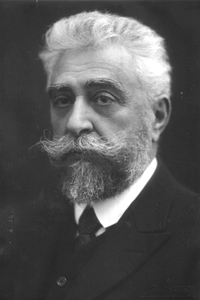Ion I. C. Brătianu
Ion I. C. Brătianu | |
|---|---|
Barbu Ştirbey | |
| Succeeded by | Petre P. Carp Alexandru Averescu Artur Văitoianu Alexandru Averescu Vintilă Brătianu |
| Personal details | |
| Born | Ionel I. C. Brătianu 20 August 1864 Eliza Știrbey |
| Profession | Engineer |
Ion Ionel Constantin Brătianu (Romanian pronunciation:
Biography
Early life
Born at Florica, his father's estate in
In 1889, he returned to the country and was assigned orders by the Army, being promoted to Lieutenant. Later in that year, he joined the Romanian Railways as an engineer, working under the leadership of Anghel Saligny.
Early politics
He became a member of the PNL in 1895, the same year he ran in elections and was elected to the
Brătianu's policies moved the PNL towards an acceptance of
World War I

The outbreak of the world conflict in 1914 brought a major polemic in Romanian society. The Conservatives oscillated between a neutral stance and participation alongside the Central Powers (to which Romania had committed itself); instead, the PNL called for an alignment with the Entente Forces. Despite the fact that Brătianu was again Prime Minister from 16 January 1914 to 9 February 1918, his policies in this respect were procrastinated. Initially, a decision on the matter was blocked by King Carol, until his death in September 1914. Afterwards, with the ascension of Ferdinand I (who was to remain a political ally of Brătianu for the rest of his life), the government started secret negotiations with the Entente, meant to condition Romania's participation with the granting of Austro-Hungarian lands with a majority Romanian population. In August 1916, Romania declared war on Austria-Hungary.
Minor advances into Transylvania were met with a Central Powers counter-offensive that swept through
In the meantime, Brătianu's had been replaced with the crisis government of General
Brătianu was antisemitic and opposed the granting of Romanian citizenship to Jews.[1][2] After World War I, however, antisemitism disappeared from the Liberals' political program, even forming alliances with Jewish politicians.
Third cabinet and support for Averescu
The spectre of
Soon, the PNL found itself threatened by the political realities of a
Fourth and fifth cabinet

The PNL retreated its backing after finding a more convenient option in a
As the
On 21 June 1927, Brătianu returned with his fifth and final cabinet. He died in Bucharest, from complications of laryngitis, and was replaced as Prime Minister by his brother Vintilă Brătianu until the calling of elections.
References
- ^ Bogdan, Caranfilof. ""Iuda sub vremuri". O contribuție la istoria antisemitismului românesc".
- ^ "Rădăcinile antisemitismului românesc" (PDF). yadvashem.org (in Romanian). Retrieved 18 June 2023.
External links
This article includes a list of general references, but it lacks sufficient corresponding inline citations. (November 2014) |
- Ion I.C. Brătianu's biography at Firstworldwar.com
- Daniel Cain: Bratianu, Ion I.C., in: 1914-1918-online. International Encyclopedia of the First World War.
- (in Romanian) Florian Bichir, Alegerile de altădată (an account of the very first universal elections in Romania)
- (in Romanian) Ioan Scurtu, Personalitatea lui Ion I. C. Brătianu
- (in Romanian) Constantin Xeni, "Ion I. C. Brătianu", in Magazin Istoric, July 2001 (a rather critical essay written by a Conservative contemporary of Brătianu)
- (in Romanian) Ion I. C. Brătianu on the Paris Peace Conference (December 1919)
- (in Romanian) National Liberal Party program of January 1922
- Newspaper clippings about Ion I. C. Brătianu in the 20th Century Press Archives of the ZBW
